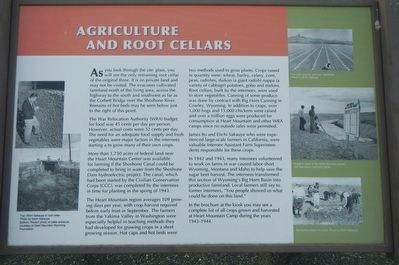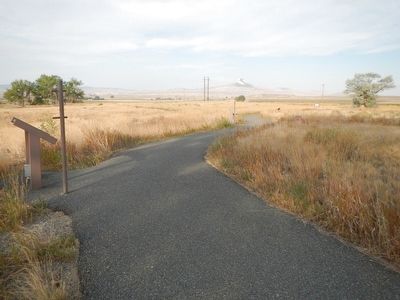Ralston in Park County, Wyoming — The American West (Mountains)
Agriculture and Root Cellars

Photographed By Barry Swackhamer, September 14, 2015
1. Agriculture and Root Cellars Marker
Captions: (left) Top: Eiichi Sakauye in root cellar, Bottom: Recent photo of cellar entrance.; (top right) Hot caps used for growing vegetable.; (middle right) Irrigation water in the Heart Mountain Canal; (bottom right) Harvesting deacon by hand.
The War Relocation Authority (WRA) budget for food was 45 cents per day per person. However, actual costs were 32 cents per day. The need for an adequate food supply and fresh vegetables were major factors in the internees starting a to grow many of their own crops.
More than 1,750 acres of federal land near the Heart Mountain Center was available for farming if the Shoshone Canal could be completed to bring water from the Shoshone Dam hydroelectric project. The canal, which had been started by the Civilian Conservation Corps (CCC), was competed by the internees in time for planting in the spring of 1943.
The Heart Mountain region averages 109 growing days per year, with crop harvest required before early frost in September. The farmers from the Yakima Valley in Washington were especially helpful in teaching methods they had developed for growing crops in a short growing season. Hot caps and hot beds were two methods used to grow plants, Crops raised in quantity were: wheat, barley, celery, corn, peas, radishes, daikon (a giant radish), nappa (a variety of cabbage), potato, gobo and melons. Root cellars, built by the internees, were used to store vegetables. Canning of some produce was done by contract with Big Horn Canning in Cowley, Wyoming. In addition to crops, over 1,000 hogs and 15,000 chickens were raised and over a million eggs were produced for consumption at Heart Mountain and other WRA camps since no outside sales were permitted.
James Ito and Eiichi Sakauye who were experienced large-scale farmers in California, were valuable Internee Assistant Farm Superintendents responsible for these crops.
In 1942 and 1943, many internees volunteered to work on farms in war caused labor-short Wyoming, Montana and Idaho to help save the sugar beet harvest. The internees transformed this section of Wyoming's Big Horn Basin into productive farmland. Local farmers still say to former internees, "You people showed us what could be done on this land."
In the brochure at the kiosk you may see a complete list of all crops grown and harvested at Heart Mountain Camp during the years 1943-1944.
Erected by Heart Mountain, Wyoming Foundation.
Topics. This historical marker is listed in these topic lists: Asian Americans • War, World II.
Location. 44° 40.189′ N, 108° 56.92′ W. Marker is in Ralston, Wyoming, in Park County. Marker can be reached from Road 19 near Lane 15, on the left when traveling west. Touch for map. Marker is at or near this postal address: 1474 Road 19, Ralston WY 82440, United States of America. Touch for directions.
Other nearby markers. At least 8 other markers are within walking distance of this marker. Swimming Hole: (a few steps from this marker); M.P. Station, Guard Tower, Rail & Train Station (a few steps from this marker); Administrative Area: (within shouting distance of this marker); Relocation Center Support Facilities (within shouting distance of this marker); Barracks Living Area: (within shouting distance of this marker); Heart Mountain High School: (within shouting distance of this marker); Hospital Complex: (within shouting distance of this marker); Heart Mountain, Wyoming - Fall 1943 (about 300 feet away, measured in a direct line). Touch for a list and map of all markers in Ralston.
More about this marker. Heart Mountain Relocation Camp is located off of the Powell Highway (U.S. Highway 14A) about 6 miles south of Ralston. This marker is located on the Setsuko Saito Higuchi Memorial Walking Tour near the Heart Mountain Relocation Center Memorial Park.
Credits. This page was last revised on June 16, 2016. It was originally submitted on December 1, 2015, by Barry Swackhamer of Brentwood, California. This page has been viewed 341 times since then and 12 times this year. Photos: 1, 2. submitted on December 1, 2015, by Barry Swackhamer of Brentwood, California.
